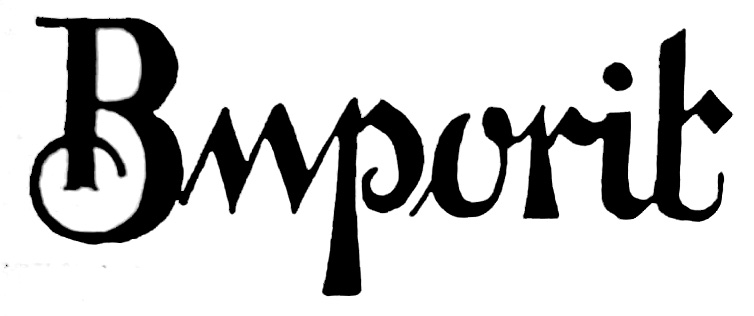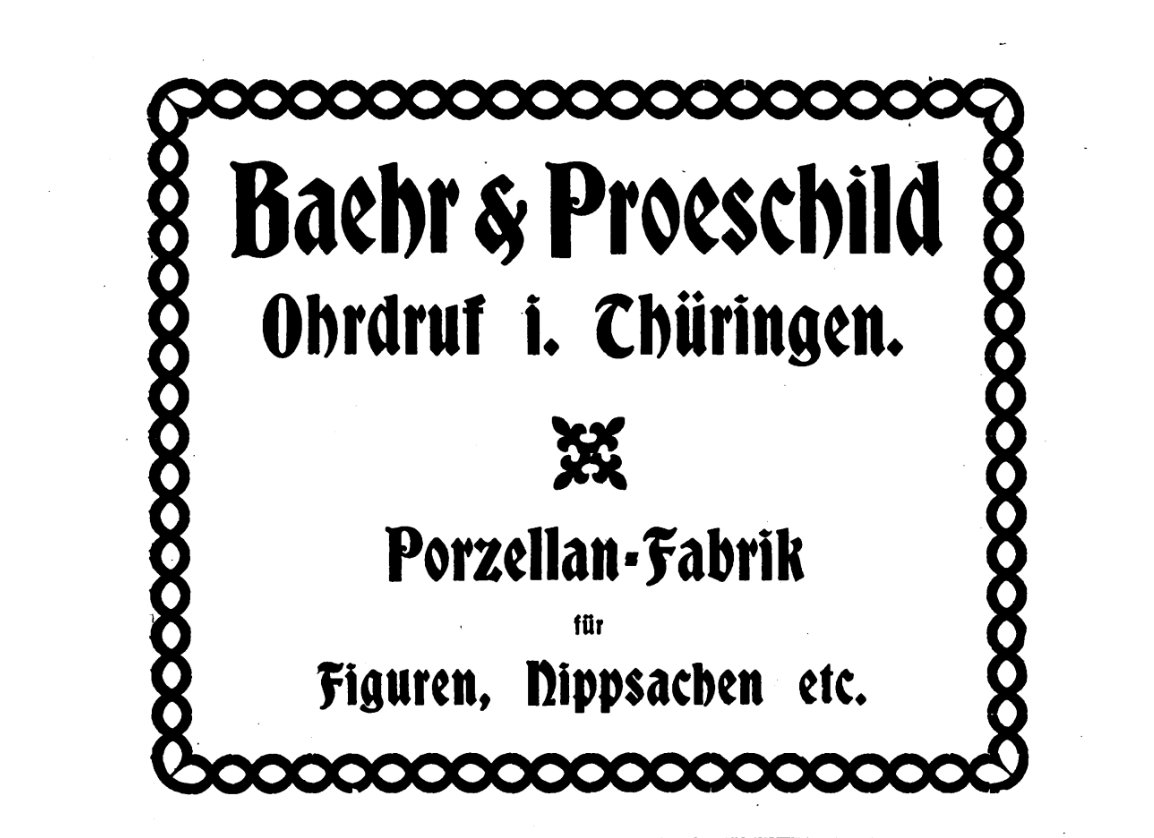Spelling BÄHR & PROESCHILD
The Baehr & Proeschild doll making company has its name spelled in various ways not only in modern texts but also in the 19th century German works. German publications sometimes show it as BÄHR & PROSCHILD with no e, and sometimes as BÄHR & PROESCHILD with only the e in the second name. The name is also often found as Baehr & Proeschild. Cieslik’s German Doll Encyclopedia spells it Baehr & Proeschild.
Spelling Variations:
For the purpose of this post, each mention will spell the name according to the resource from which it came. Therefore click the links to see the sources for yourself.
The Baehr & Proeschild Doll Marks
Early dolls made by Baehr & Proeschild (or BÄHR & PROESCHILD) may not have any marks because they were founded during a decade before the need for marks was recognized. Later doll heads have the letters BP. Some may have the shape of a heart with the BP others may have crossed swords with the BP. Early ones may not have the BP. Some BP doll heads have the “dep” letters for the French market.
doll head marks can be:
- none
- BP
- BP dep
- image of crossed swords with the letters BP
They made some doll heads for:
- Bruno Schmidt of Waltershausen
- Kley & Hahn
- Adolf Wislizenus of Waltershausen
- Josef Bergmann of Waltershausen
- and Heinrich Stier of Sonneberg
Founders
Georg Baehr and August Proeschild (died Nov 16, 1894 at age 62) founded the company in 1871. One can see Georg BÄHR mentioned as a merchant and factory owner in Ohrdruf in the German newspaper Coburger Zeitung in 1891. The Leipzig Fair Addressbook in 1906 claimed they existed since 1870.
BÄHR & PROESCHILD 1873 Full Page Advertisement
In 1873 AD BÄHR & PROESCHILD (or Baehr & Proeschild) of Ohrdruf in Thüringen Germany advertised their porcelain factory (porzellan fabrik) delivering finely styled bisque and glazed doll heads, doll frames, figures, bathing children, etc. at the trade fair in Leipzig: Auerbach’s farm (vault no. 47) (as translated). The ad appeared in the German publication “Address Book of the Export Businesses of the German Empire and Austria-Hungary, from Leuchs & Co.” (Adressbuch der Export-Geschäfte des Deutschen Reiches und Oesterreich-Ungarns, von Leuchs & Co.).
The same year of 1873 their company’s listing on other pages of the same German addressbook have the name spelled as BÄHR & PROSCHILD (Baehr & Proeschild).
In 1878 Baehr & Proeschild are found listed with J. D. Kestner and Kling & Co. for their porcelain factory manufacturing doll heads, doll frames, bathing children, figures and toys in the Duchy of Gotha. (1878, Adressbuch der der Kaufleute, Fabrikanten und Gewerbsleute. p544).
The Handels- und Gewerbs-Adressbuch des Deutschen Reichs (Commercial Address Book for the German Empire) for 1880 lists BÄHR & PROESCHILD along with Kestner & Co. and Kling, C. F. & Co. as owners of porcelain factories in Ohrdruf.
The book “Walks through Thuringien” (Wanderungen durch Thüringen) in 1895 reported that the Baehr & Proeschild in Ohrdruf porcelain factory had 200 workers.
The Tonindustrie-Zeitung und Keramische Rundschau magazine in 1900 noted Baehr & Proeschild in Ohrdruf as manufacturing new items in the figurative genre worth mentioning include: Allegorical flower figures in sharp-fire colors.
1896 Leipzig Trade Fair Address Book
The Official Trade Fair Address Book for Leipzig of 1896 (Officielles Mess-Adressbuch für Leipzig) gave the listing for Baehr & Proeschild a. Ohrdurf (Thür.), Porzellanfabrik. – Peterssir. 36, I (nur zur Ostermesse).
1904 Patent
Patentblatt announced a patent for Baehr & Proeschild in 1904, “Doll’s head with eyes that can be moved up and down and to the right and left, and are connected to each other by a crosspiece that is suspended in a pendulum and loaded with a weight.”
1905 Half Page Ad
A simple half page ad appeared in 1905 in the German publication, “Aus der zweiten Heimat : Reisen und Eindrücke eines Buren in Deutschland” by J.P. Jooste (From the second home: travels and impressions of a Boer in Germany.) The ad simply read (translated), “Baehr & Proeschild; Ohrdruf in Thuringia. Porcelain factory for figurines, knick-knacks etc.” The name contains the vowel “e” in both names.
1906 Adressbuch der Keramischen Industrie
The Adressbuch der keramischen industrie (Germany’s Ceramic Industry’s Addressbook) provided the following listing information in 1906: (translated)
Baehr & Proeschild, porcelain factory in Ohrdruf (P. T. and E.), Saxony-Coburg-Gotha. Telegr. address: The company. Telephone No. 3. Owners: Jos. Augesky and Hans Schütz.
(1906). Adressbuch der keramischen industrie: enthaltend die firmen der fabriken für porzellan, steingut, favence, majolika … in Deutschland und Oesterreich-Ungarn, mit den fabrikmarken. 9. aufl. Coburg: Müller.
Manufacture: Doll heads, Nanking dolls, bathing children, doll wigs, movable porcelain children, holy water stoups, saint figures, figures, knick-knacks, animal groups, ash trays, etc. Spec.: Doll heads, saint articles and figures. Export to all countries. Painting. Sample warehouse and representatives in Hamburg, Grosse Reichenstrasse 63 I, G. C. J. Harten; Berlin SW. 13, Alexandrinenstrasse 23, Paul Christoph.-For the trade fair in Leipzig: Silver Bear, 2nd floor, room 8, water turbine operation, own mass mill. In existence since 1870. 150 workers.
1907 Address
They listed the address of 81, Gothaer- str., Ohrdruf (Thur.) in 1907.
In 1909 Baehr & Proeschild Listing
The Spechsaal publication in 1909 gave this listing (transated) for Baehr & Proeschild:
Baehr & Proeschild, a porcelain factory in Ohrdruf in Thuringia, have added a whole series of pretty new types to their knick-knack exhibition. Children’s sports are the main focus now, so you can see children playing snowballs and sliding, sledders, etc. in a lovely warm ivory tone. Last year’s figures: harper, village hero, village prince, bird seller, village Grete are still very popular and are readily purchased. There are also new items in the form of domestic animals and wild animals, as well as groups of these, specially calculated for sale in 50 Pfennig and 1 Mark. In addition to the well-known images of saints, the Munich Child is also on display.
1909. Sprechsaal. Coburg, Germany : Müller & Schmidt.
BUPORIT Trademark

The firm applied for the word trademark BUPORIT (128801) in 1909 which registered in 1910 to represent their business manufacturing of celluloid-like material. Goods: Dolls, doll parts and other toys made from celluloid-like materials.
1911 Royal Awards
In 1911 the Government Gazette for the Duchy of Coburg announced, “His Royal Highness the Duke has been graciously moved to award the Knight’s Cross 2nd Class of the Duke’s Order of St. Ernestine to the member of the Trade Council and the Chamber of Commerce, factory owner Hans Bähr in Ohrdruf. Gotba, May 24, 1911.
Baehr & Proeschild to Bruno Schmidt
In 1918 The Keramische Rundschau announced, “Change of ownership. The Baehr & Proeschild porcelain factory in Ohrdruf has been transferred to the doll manufacturer Bruno Schmidt in Waltershausen.” Bruno Schmidt continued the business under the name Baehr & Proeschild.
Bruno Schmidt dolls may have the heart shape around the BSW letters showing his connection to the Baehr & Proeschild business who used the heart first.

A year later in 1919 under the ownership of Bruno Schmidt, the Baehr & Proeschild name registered the trademark with the heart and letters BP underneath it (233082) which associates with the heart in Bruno Schmidt’s trademarks.
Willy Meyer and Arthur Muller 1921
The German publication Sprechsaal in 1921 announced that the merchants Willy Meyer and Arthur Muller had general power of attorney.
